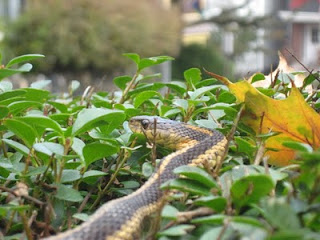I was pretty excited to read his book. The fifty artifacts Bagley examines range from prayer books to feminine hygiene devices, but the one that really caught my attention was a cat skeleton unearthed in Charlestown. Many, many cats have lived and died in Charlestown over the last 400 years, but this cat was possibly killed as part of a magic spell.
Its skeleton was found buried in a small pit underneath the main entrance to the former Three Cranes Tavern in Charlestown's City Square. The tavern operated from 1635 until 1775, but the archaeologists who found the cat skeleton estimated it was buried sometime in the early 1700s. The cat was killed by a blow to the back of its head. The blow punctured the poor cat's skull, and its body was buried in one piece. Also buried near the cat was a large pot.
Bagley speculates that the cat was buried there to magically protect the tavern, either from witchcraft or from vermin. This certainly seems possible, since it's unlikely the tavern owners would just randomly bury a cat under the front stoop. Archeologists have found many instances of cats buried under foundations or inside walls of old buildings in Europe. Occasionally dead mice or rats are also found placed inside the cats' mouths.
There are a few theories that try to explain this practice. An older theory, popular with the Victorians, is that these animals were killed to appease land spirits. That may have been the case in the distant pagan past, but the English colonists certainly didn't believe in land spirits that needed appeasing.
A more recent theory is that the cats were killed to prevent rats and mice from entering the house. This seems counter-intuitive (wouldn't a live cat be more effective?), but I think the idea is that the cat's spirit will somehow continue to hunt mice after death. This might explain why some buried cats are found with mice inserted in their mouths.
 |
| The Three Cranes cat skeleton. Photo from The Boston Globe. |
There is a whole field of archaeology that deals with magic. Its foundational text is Ralph Merrifield's The Archaeology of Ritual and Magic (1987), which should probably be on my reading list. It should probably be on everyone's list! If you find this topic interesting, you may want to read this interview with Brian Hoggard, a British archaeologist working on this topic today.
My cat is sitting nearby as I write this post, and he tells me that a live cat is definitely better at averting evil than a dead one. I would have to agree. After all, the cat skeleton didn't do much to protect Three Cranes Tavern on June 17, 1775. The Battle of Bunker Hill happened that day, and the British troops burned the tavern and the rest of Charlestown to the ground. The tavern foundations were excavated prior to the Big Dig and can now be visited in City Square.
Although I enjoy writing about these old folk magic practices, I don't recommend ever hurting or killing animals. Not only is it cruel, it is illegal.

